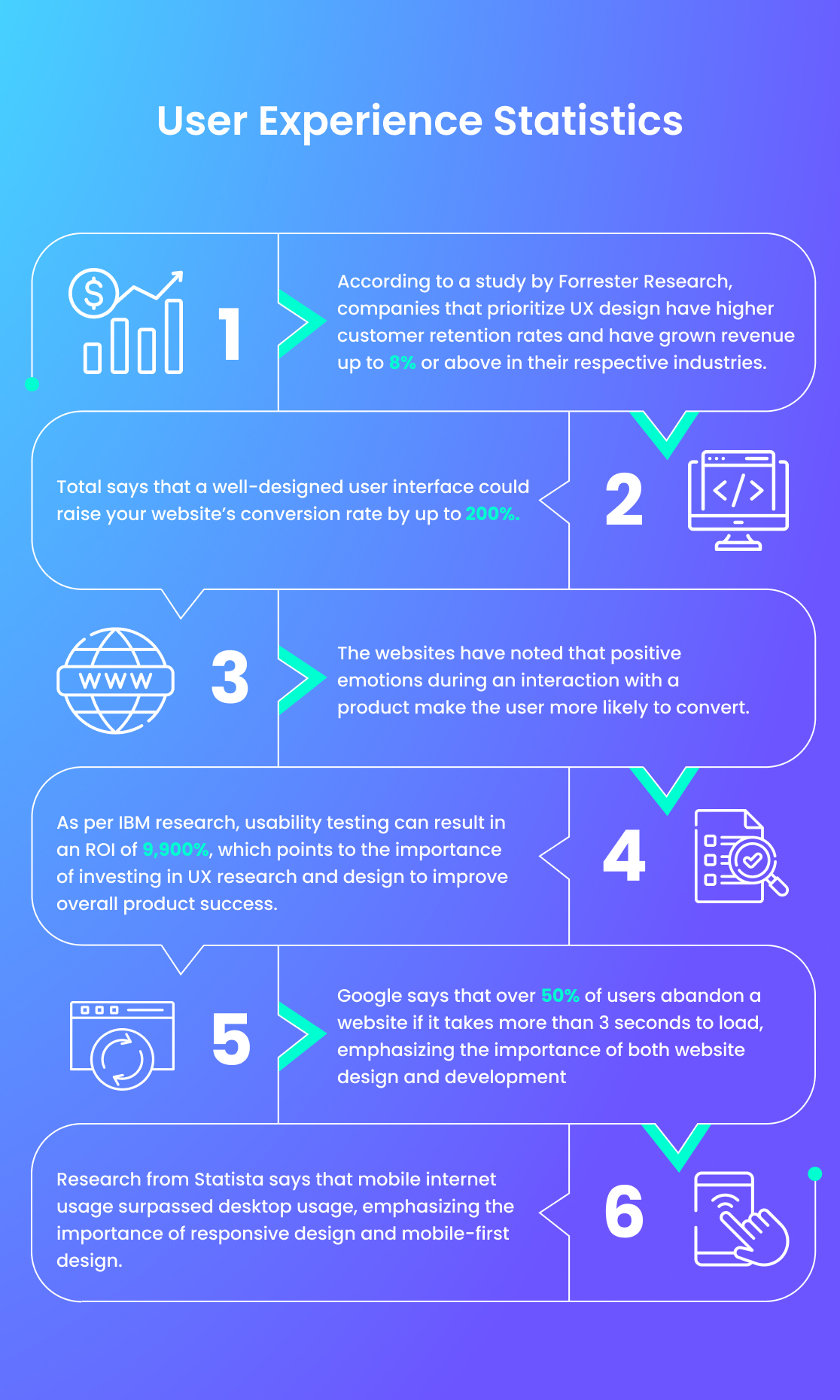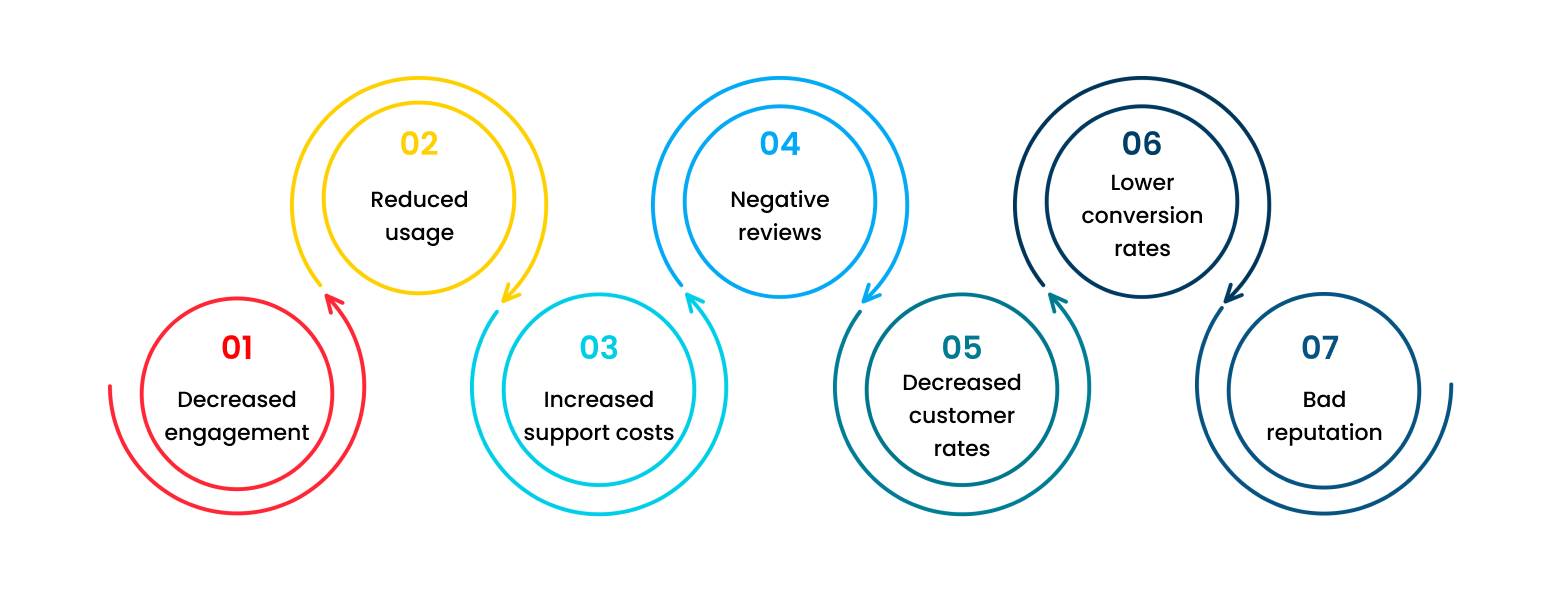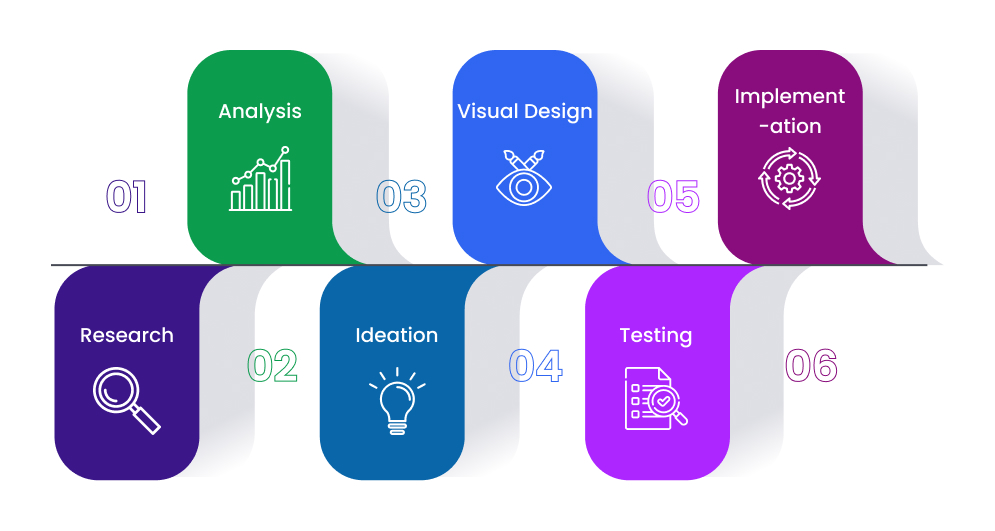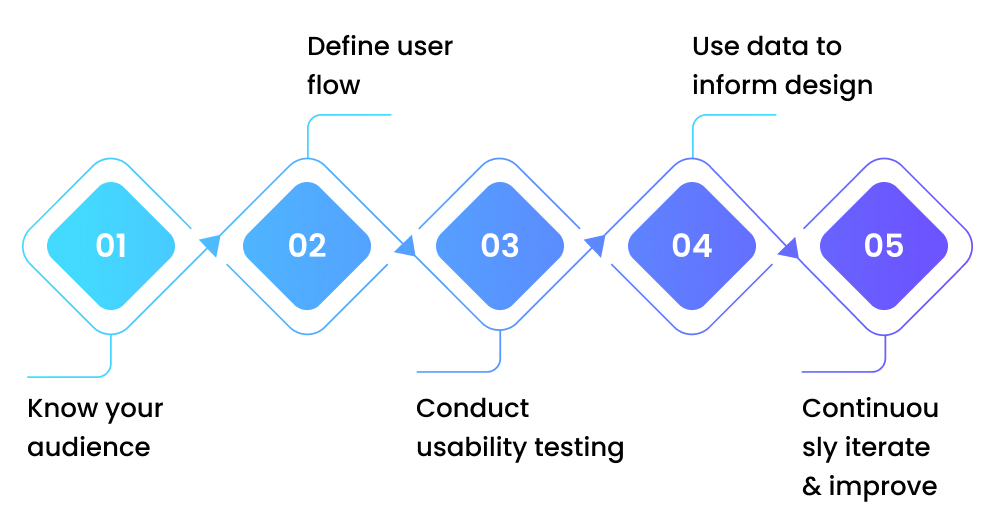- Apr 25, 2023
- Web Design
- 6678
Share this post on:

Have you ever wondered what it is that makes customers stay on a website for a longer time? Or why are some websites easy to navigate?
In today’s industry, UX designs are playing a major role in developing efficient websites that help customers stay for a longer period. A great UX design helps businesses guide their customers and convey their business goals.
Let us see what the user experience statistics have to say:
- According to a study by Forrester Research, companies that prioritize UX design have higher customer retention rates and have grown revenue up to 8% or above in their respective industries.
- Toptal says that a well-designed user interface could raise your website’s conversion rate by up to 200%.
- The websites have noted that positive emotions during an interaction with a product make the user more likely to convert.
- As per IBM research, usability testing can result in an ROI of 9,900%, which points to the importance of investing in UX research and design to improve overall product success.
- Google says that over 50% of users abandon a website if it takes more than 3 seconds to load, emphasizing the importance of website design and development.
- Research from Statista says that mobile internet usage surpassed desktop usage, emphasizing the importance of responsive design and mobile-first design.

What is the effect of bad UX/UI?
Bad UX or UI can lead to a frustrating experience for users and can result in dissatisfaction with the product or service. Here is the effect of bad UI/UX:

- Decreased engagement: Users are less likely to engage with a product or service that has a poor user experience.
- Reduced usage: Poor UX or UI can result in declining usage of a product or service. It ultimately leads to lower revenues.
- Increased support costs: Bad UX or UI can lead to an increase in support costs, as users are more likely to require help and assistance.
- Negative Reviews: Users leave negative reviews and feedback on products or services with poor UX or UI.
- Decreased customer loyalty: Bad UX or UI can decrease customer loyalty. Because if the design is poor, it can motivate users to switch to your competitor's product or service.
- Lower conversion rates: Poor UX or UI can result in lower conversion rates, as users are less likely to complete actions like making a purchase or filling out a form.
- Bad reputation: A poor user experience can quickly damage a company's reputation and brand image.
How can UX design help improve your business?
UX design is a crucial element for businesses looking to improve their overall performance. It offers business opportunities to create user-friendly and interactive designs that enhance the user experience. This leads to increased customer satisfaction, a stronger brand identity, productivity and efficiency, and valuable customer insights. These benefits ultimately contribute to increased sales, customer retention, and the long-term success of the business.

Enhanced User Experience: UX designers focus on creating user-oriented designs that cater to the needs of the target audience. By doing this, businesses can enhance the overall user experience. Improved user experience means that individuals find it easy to navigate through a website or application, the relevant information is displayed efficiently, and it takes them less time to access the desired information.
This enhanced user experience can result in a growing number of satisfied users and help convert them into loyal customers who can promote the product to their peers. Businesses will be more likely to achieve higher sales conversions, a reduced bounce rate, and increased customer retention with increased customer satisfaction.
Improved Customer Engagement: Engagement is one of the critical factors that determine the success of a product or service. UX designers create user-friendly and interactive designs, which can increase customer engagement. The result is a better connection between the brand and the customer.
An improved engagement level increases customer trust and loyalty toward the business. Customers tend to stick with a brand that they have a better connection, which can lead to repeat business and referrals.
Stronger Brand Identity: The use of UX design can help a business establish a strong brand identity. A well-designed user interface can provide businesses with an opportunity to create a unique and identifiable brand identity. The design elements used within the interface, such as the company's logo, color scheme, and typography, play a vital role in establishing a brand identity.
A strong brand identity makes it easier for businesses to stand out in a competitive market and helps customers remember their brand. This can lead to increased brand recognition and recall, which can increase sales and customer loyalty.
Increased Productivity and Efficiency: Integrating UX design can significantly increase the productivity and efficiency of businesses. Businesses can reduce the time spent on training and support issues by focusing on user-friendly designs. Simple and intuitive designs can reduce the learning curve and increase the overall efficiency of the product or service.
An efficient product leads to increased productivity, as users can complete tasks quickly and efficiently. It can also result in a reduction in support costs, increased worker satisfaction, and reduced turnover rates.
Better Customer Feedback and Insights: UX design can also help businesses obtain valuable feedback and insights from their customers. The interactive nature of UX design allows businesses to gather data on how customers interact with their products. This information can help businesses improve the overall design and functionality of their products.
Feedback and customer insights help businesses stay ahead of their competitors. By continually improving their designs, they can create better products that satisfy the needs of their target audience.
What are the different stages of the UX design process?
Each stage of the UX design process is critical and plays a vital role in creating a user-centered design that meets the user's needs and expectations. UX designers can create products that are intuitive, easy to use, and meet user needs and expectations by following these stages. Here are the stages involved in the UX design process:

Research: The first stage of the UX design process is research and analysis. This stage involves gathering information about the users, their needs, and the context in which the product will be used. The objective is to gain an understanding of the user’s behavior, preferences, and expectations. The research can be conducted using various methods, such as surveys, interviews, and user testing.
Analysis: The analysis part involves analyzing the data that has been collected and identifying patterns and trends. This stage is critical as it helps the designer create a user-centered design that meets the user’s needs and expectations.
Ideation: In this phase, UX designers generate ideas and explore different design possibilities. They create sketches, wireframes, and prototypes to visualize their concepts.
Visual Designs: In this stage, designers use the insights and ideas generated in previous stages to create a final design solution. They create high-fidelity mockups and test the design to ensure that it meets the needs and goals of the user.
Testing: The third stage of the UX design process is testing. This stage involves testing the product with users to identify any usability issues. The objective is to identify and fix any issues before the product is launched.
The testing stage is critical, ensuring the product is user-friendly and meets the user’s needs and expectations. Testing can be done using various methods, such as user testing, A/B testing, and usability testing.
Implementation: This stage involves developing the product and launching it. The objective is to ensure the product meets the user’s needs and expectations.
The implementation stage is critical as it is the final step in the UX design process. It is necessary to ensure the product is launched on time and within budget. Also, ensure that the product is marketed effectively to increase visibility and user adoption.
How can businesses successfully implement UX designs?
Here are a few points that can help businesses successfully implement UX designs:

- Know your audience: This is the first step in UX improvement. It is crucial to know the audience and understand their needs. This can be done by gathering target user feedback, conducting user research, and analyzing user data to identify areas where improvements are needed.
- Define user flows: Once businesses know the user flow and audience needs, they can define the user flow that needs to be optimized. It includes mapping specific tasks or steps and understanding the pain points or areas of friction.
- Conduct usability testing: Usability testing is critical in UX design. It helps businesses identify any usability issues with the product and provides insights into how users interact. So it is mandatory to conduct usability testing regularly to ensure the product is meeting the user's needs and expectations.
- Use data to inform design: Collecting user data is an essential way to improve UX. The data involves website analytics, user research, A/B testing results, and more. It helps businesses analyze areas of improvement and make better decisions.
- Continuously iterate and improve: UX improvement is a continuous process and requires continuous iteration. Simply put, businesses need to constantly gather user feedback, test new designs, and more so that they can improve the product as per user or market requirements.
How to become a UX designer?
UX design is a vast field that requires a highly diverse skill set. It is a challenging but financially rewarding career. Moreover, the best part of the job is that there is no need for a standard background. But there are a few qualities and attributes that are required to become a good UX designer:
- Designers must have the ability to think creatively and analytically.
- Have a user-first mindset and knowledge of the latest designs.
- Interest in problem-solving.
- Strong communication skills.
- Ability to collaborate.
Essential skills UX designers must have
Here are the following skills that are must-haves for UX designers:
1. Prototyping, wireframing, and user flows: Prototyping helps in design testing and refining ideas, and wireframing helps in developing a visual representation of the design layout. User flows help in understanding how the user interacts with the product or service.
2. Visual design and design software: UX/UI designers use visual design software such as Figma, Sketch, Photoshop, and Illustrator. So, it is crucial to know this software. So, it is vital to know visual design best practices such as typography, color therapy, icons, and layout.
3. Information Architecture: Information Architecture (IA) helps designers organize and structure content. It provides them with the necessary information that helps them complete their task.
To conclude:
Implementing UX design offers customers a great experience and a great methodology that allows designers to improve their designs.
So, if you are looking to boost your business revenue, OZVID is a perfect choice.
We at OZVID offer the best and most efficient web designs that help businesses attract more customers and help them generate more profit.











